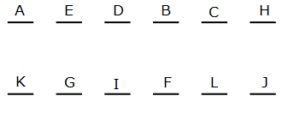Navigating the world of competitive exams, like Bank, SSC, and MBA tests, requires students to learn some very important topics. Among them, “Reasoning Puzzle Questions” and “Seating Arrangement Questions” are two big ones. These questions help test-takers prove their thinking skills in the exams and also improve their general logical abilities.
So, what are “Reasoning Puzzle Questions“? These questions make students think hard and use the given clues to find answers. They challenge the students to connect different pieces of information in a logical way, helping improve their thinking skills.
Now, let’s talk about “Seating Arrangement Questions“. These questions test how well a person can picture and set up information in their mind. They need a lot of focus, patience, and understanding of tricky instructions. They’re key for knowing if a student is good at problem-solving.
Interestingly, many tests mix “puzzle and seating arrangement” together. When we see “puzzles & seating arrangement” in a question, it means students need to use both skills to find the answer. This mix of “puzzle seating arrangement” shows how important these topics are.
There are also other materials like “puzzle questions reasoning” that give more details about the different puzzle types. Some students, while studying these reasoning topics, also look at resources from other subjects, like “puzzle and seating arrangement”, to strengthen their overall skills.
To wrap it up, “Reasoning Puzzle Questions” and “Seating Arrangement Questions” are more than just exam topics. They are crucial skills needed in many job fields. So, learning the details of “puzzle and seating arrangement” is not only for passing exams but also for future career success. Study hard, practice a lot, and use these topics to shine in the world of competitive exams!
Set-43
12 persons A, B, C, D, E, F, G, H, I, J, K and L are standing in two parallel rows in such a way that 6 persons from row 1 are facing north and 6 persons from row 2 are facing south. Every person from row 1 is facing one person from row 2.
• F is standing 2nd to the right of G and is facing B.
• More than 1 persons are standing to the left of B.
• C is standing at the gap of 2 persons from the one facing G.
• A and J are standing diagonally opposite to each other at the extreme end of their rows.
• J is standing to the right of G.
• H is facing J and standing diagonally opposite to K at the extreme end of the row.
• D is facing I, who is not the neighbour of L.
• D is standing to the left of E. A is facing south direction.
1. Who is standing 2nd to the left of D?
2. Who is facing C?
3. Find the odd one out.
4. Who among the following is the neighbour of D?
5. __ is facing E?
Set-44
Six companies – A, B, C, D, E and F have their offices in different cities. The area of each office is different.
• B’s office is larger than the office in Gurgaon with a gap of 2 offices in between them.
• Only one office is larger than B’s office, and B’s office is not in Bangalore.
• F’s office is neither in Gurgaon nor is smallest.
• Office in Chennai is larger than C’s office, which is in Chandigarh.
• E’s office is larger than all those offices which are larger than office in Mumbai.
• D’s office is in Chennai, which is smaller than office in Bangalore.
• Office in Mumbai is smaller than office in Delhi.
• F’s office is smaller than D’s office which is not the largest.
6. Which office is the smallest one in area?
7. How many offices are larger than the office in Mumbai?
8. Where is F’s office situated?
9. Which company’s office is in Delhi?
10. How many offices of the following are smaller than A’s office?
I: C
II: F
III: D

